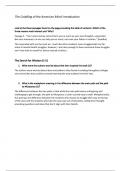Tentamen (uitwerkingen)
The Coddling of the American Mind - Introduction Questions
- Vak
- Instelling
- Boek
These are the answered questions assigned for the introduction of Coddling of the American Mind in an HHG4M1 course.. Answers include quotations, page numbers, and personal opinions.
[Meer zien]




